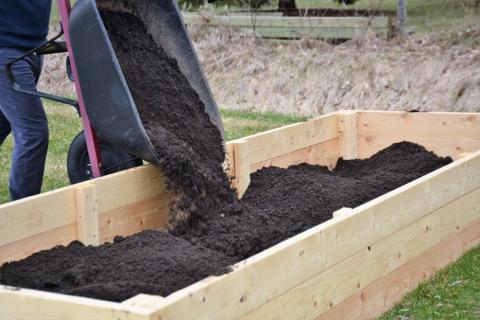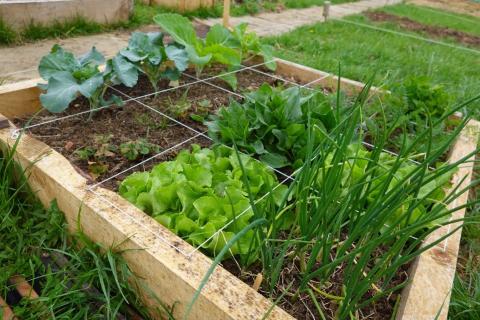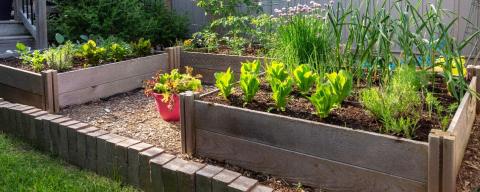How to Utilize Raised Beds for Small Space Gardening
If you think that having a very small yard or even no yard at all means that you can’t have an awesome garden, think again! Having space restrictions doesn’t mean you can’t garden; it just means that you might have to get a little creative to take advantage of the spaces you do have to grow! You may, in fact, surprise yourself with how much you can grow — flowers, vegetables or even fruit if you use a few tried and true tips and tricks from the principles of small-scale intensive growing.
There are many levels of small-scale growing — from a small backyard with raised beds to a front stoop with some containers to growing indoors under lights (if you truly don’t have any outdoor space). For this blog post we are going to dive into the world of raised bed gardening. Let’s dig in!
Raised beds are a great way to garden in small spaces if you have a yard with enough exposure to the sun. Raised beds are particularly fitting in situations where soil is very compacted, contaminated with lead or other heavy metals, nutrient-poor or if you have no soil at all, such as if you want to grow on an old driveway or on asphalt. Building a raised garden bed on top of poor soil or no soil can be a great way to build a garden without making drastic changes to your space and it can also be removed if you move out or want to upgrade your garden down the line. Other reasons to use raised beds are that they will warm up faster in the spring for planting, they are easier to weed because you don’t have “grass-creep” coming in along the edges of your garden space, they are more ergonomic (think less bending over for weeding, watering and harvesting) and being raised off the ground, they also encourage good drainage.
Materials and Structure
Raised beds can be made with wood, engineered decking boards, metal, stone, woven twigs or other materials so long as the structure holds soil and doesn’t contain any chemicals that will leach into your soil. The safety of using chemically treated lumber (usually called pressure treated) is widely debated. Arsenic is no longer used as a wood preserver in the pressure treating process, however the USDA still does not allow the use of any chemically treated lumber to be in contact with soil used for growing in organic-certified agriculture. Cedar and redwood boards have natural rot resistance, but these can be a lot more expensive than pine, hemlock or Douglas fir. You can expect untreated wooden beds to last three to five years and cedar or redwood made beds to last 10 years or more. Penn State Extension has a couple of great resources on building basic wooden raised beds. You can find written instructions here and a video guide here.
Bed Size
One of the great advantages of building your own garden beds is that you can build them to the size and shape that best fits your space. Beds don’t need to be excessively tall or wide to gain the benefits mentioned above; just remember that they need to have an open bottom or to have drainage holes if you’re using a metal trough-style bed or something that has a structure on the underside. We recommend not making the beds too wide because that can limit access to the center of the growing space. If you place your garden bed in a location that you have access on all sides, three to four feet should be the maximum width before you need to start stepping into the bed for weeding and harvesting, which we don’t recommend. If your garden bed is up against a structure such as a house, shed, or fence, two to two and a half feet wide should be the maximum. The length of the beds doesn’t matter as much but for anything over four feet long we recommend installing a brace in the middle of the bed to prevent the boards from bowing out due to the weight of the soil. Don’t forget to install trellises if you like to grow vining or climbing plants like peas, beans, tomatoes, cucumbers, clematis or trumpet flowers. It’s much easier to install trellises before or during planting rather than once the plants are already growing.
Filling the Beds
We usually recommend filling raised beds with a mix of 70% topsoil, 30% high-quality compost. Taller beds can be great if you have limited mobility, or if you simply like the idea of not having to bend over as much to tend to your garden. However, taller beds both take more materials to build (read: more expensive) as well as take more soil to fill. Not much can be done on the building material side for tall beds but on the soil side you can borrow a part of the German practice of “Hügelkultur” by first placing down some logs and/or sticks at the bottom of the bed to fill some space before you put your soil in. This has the added benefit of the wood at the bottom acting like a sponge — it holds onto water as it breaks down, leading to reduced water needs in your garden.

Filling raised bed with soil
Buying a Soil Mix
It is often most cost effective to buy materials such as topsoil and compost in bulk rather than in bagged form. Plus, bulk materials eliminate the use of the extra plastic bags that most soil and amendments are packaged in. Many garden stores will load up your own truck if you have one with a bucket loader (don’t forget to place a tarp down first when loading to make it easier to unload) or many of them will deliver to your home for a fee if you don’t have a truck. If you can, inspect the material before you purchase it to make sure it is what they claim it to be, and for compost, that it is a totally finished product. What you should avoid is topsoil with lots of rocks or debris and compost that has an off odor, is excessively clumpy and wet, or if you can see materials that have not broken down yet. Compost should be dark, fine and should smell earthy, not foul in any way.
Maximizing Yields in Raised Beds
Because raised beds have a limited amount of space, it can be tempting to overload this type of garden, especially when direct seeding and planting small transplants. Remember, some plants can grow very large! A single tomato plant, for example, requires a minimum of 18 inches in all directions to have enough space to properly grow. Two foot spacing, especially for indeterminate varieties, is even better. A great way to maximize your growing yields is to use the principle of “square foot gardening” in small growing spaces such as raised beds. This intensive growing method involves breaking up a garden space into a one foot by one foot grid with suggestions on how closely to space each crop. Here is a resource on square foot gardening and how to do it in your garden. Installing a trellis to allow vining crops such as tomatoes, cucumbers, peas and beans to grow vertically is also a great way to maximize your space. As mentioned above, it’s best to install the trellis before planting to minimize disturbance to your plants.

A great way to maximize your growing yields is to use “square foot gardening” in small growing spaces such as raised beds.
Water Needs for Raised Beds
Although still possible, it’s difficult to overwater a raised bed garden because of the volume of soil and the raised design. Underwatering, however, is relatively easy to do. Most flower and vegetable crops require about an inch of rain or irrigation per week. Sticking your finger into the soil will give you a pretty good idea of whether you need to water more or not. If it’s still dry past one or two inches from the surface, it needs more water. Installing drip irrigation is the most efficient method of watering the plants in your garden because the water goes directly into the soil and thus to the plant roots with minimal evaporation or splash. It can also help limit pathogens, which can spread by water droplets from leaf to leaf and plant to plant. For more information about garden irrigation, have a look at this article from UNH Extension, which covers the basics of installing watering systems.
Fertilizing
Starting with a high-quality topsoil/compost mixture will help to set yourself up for success. As you continue to use your raised bed year after year, you will probably notice a couple of things. First, your level of soil will decrease over time. This is due to soil compacting and can be remedied by simply adding more topsoil/compost mix or just compost. The other thing you may notice is that the fertility of the bed will decrease without intervention. You may see this in lower yields or plants being more susceptible to disease. We highly recommend getting your soil tested to know if there are any imbalances in pH or nutrient levels. The Home Grounds and Garden report will also give you both conventional and organic fertilizer recommendations for correcting any imbalance or deficits. For information about getting your soil tested, please visit the UNH Extension Soil Testing Services website.
Do you love learning about stuff like this?
SUBSCRIBE TO Granite State Gardening newsletter
Got questions? The UNH Extension Yard and Garden Infoline offers practical help finding answers for your yard and garden questions.
Call toll free at 1-877-398-4769, Monday to Friday, 9 a.m. to 2 p.m., or fill out webform.

